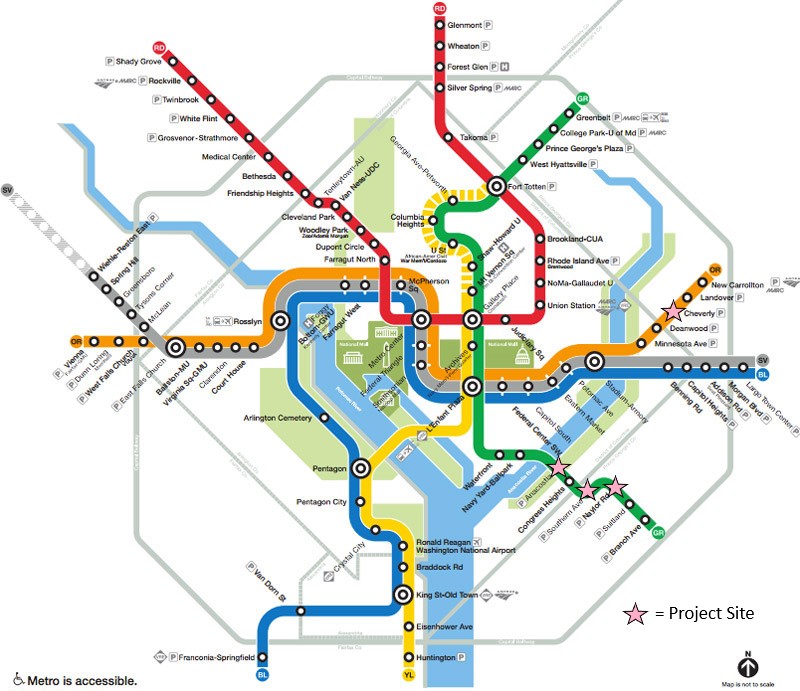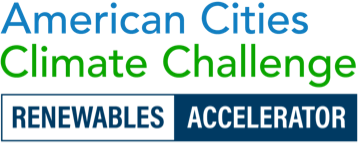Local Government:
Washington Metropolitan Area Transit Authority (Metro) and Washington, District of ColumbiaProject:
Community Solar on Metro SitesCategory:
Community Solar, Partnerships and CollaborationsProject Purpose
To lease space on Metro properties for the installation of 12.8 MW of community solar projects and generate reliable, long-term revenue for Metro.
Project Overview

In July 2020, Metro announced a partnership with SunPower Corp and Goldman Sachs Renewable Power LLC (GSRP) to install and operate 12.8 MW of solar carports and canopies at four Metrorail stations, covering three surface parking lots and two parking garages. SunPower will install the solar panels at no cost to Metro, creating the largest community solar project in the National Capital Region. GSRP will own the solar canopies and renewable energy credits (RECs) and will deliver annual payments to Metro over a 25-year period, providing a reliable, long-term revenue stream to support the agency’s operations.
Metro is a tri-jurisdictional government agency—created through an interstate compact between the District of Columbia, State of Maryland, and Commonwealth of Virginia—that operates the regional transportation system in the National Capital Region. Without direct taxing authority, Metro depends on funding from member jurisdictions to support capital and operating expenses. This subsidizes revenue generated from fares, advertising, real estate, and other sources, as Metro pursues innovative new opportunities to grow revenue.
In 2018, the District of Columbia released its Clean Energy DC Plan, providing some of the most attractive incentive programs for solar energy projects in the country. Leasing space for solar energy generation on Metro-owned sites offered the transit agency the potential for new revenue streams. Metro enlisted JLL, a global commercial real estate services company, to assist the agency in identifying opportunities to develop solar generation at its sites while also generating revenue.
Following a request for proposals, Metro selected SunPower and GSRP as partners on a 25-year leasing agreement that allows the partners to install and operate solar panels on parking facilities at Metro’s Anacostia, Cheverly, Naylor Road, and Southern Avenue Metrorail stations. Under the contract, the solar canopies will generate clean energy for nearby communities, and Metro will receive annual lease payments totaling approximately $50 million over the course of the contract period.
As the largest community solar project in the National Capital Region and one of the largest in the country, the project will provide a clean source of energy that will be delivered to homes and businesses across the region. Construction on the solar sites will begin in 2021, and once the panels are operational, they will generate enough renewable electricity to power the equivalent of at least 1,500 households. The solar-generated power won’t be used by Metro. Instead, residential and business customers in Pepco’s District of Columbia and Maryland service territories will be able to sign up for a share of the energy while saving on their utility bills.
“This project benefits residents of our region, even people who don’t ride Metro, by leveraging the potential of our stations to generate revenue and increase the community’s access to a clean, renewable source of energy. This project advances the region’s sustainability goals.”
Metro General Manager/CEO Paul J. Wiedefeld
What were Metro’s biggest challenges in setting up this project?
Identifying the best-suited sites: Metro oversees one of the largest transit systems in the country, providing service across a 1,500 square mile area. The agency owns or controls real estate assets throughout its operating region, including 91 stations and 117 miles of track for Metrorail and nearly 10,700 bus stops for Metrobus. The project’s viability depended upon whether the agency could use locations covered by District of Columbia solar incentives and where grid interconnection was feasible. With a system and assets as large as Metro’s, conducting an analysis to identify the sites best suited for solar installations required extensive time and resources.
Allocating energy: Early on, Metro evaluated whether solar energy from this project should be used to power its own operations or whether it would flow directly to the grid to benefit the local community. Supplying the community solar market through a lease structure maximized solar generation and financial value to Metro while reducing implementation risk for the project.
Balancing agency goals with partner incentives: Metro sought to optimize power generation, maintain safe transit operations, and maximize revenue. At the same time, the terms for any project agreement needed to remain attractive enough to incentivize potential partners.
What advice would Metro give other local governments as they pursue climate action projects?
Consider innovative project structures and financing: This solar project comes at no cost to Metro and will result in approximately $50 million of revenue for the agency. Metro would have been challenged to finance a solar project on its own and would have lacked some of the internal expertise needed to operate and maintain any solar installations. However, Metro found a way to leverage its extensive real estate assets to attract partners that were better positioned to manage financing and operations. There are many ways to set up and finance renewable energy projects; assess what contributions can be brought to the table for a project and consider creative structures and financing options.
Seek out opportunities that deliver shared regional benefits: With this project, Metro saw an opportunity to advance the agency’s goals alongside those of other local stakeholders. Ultimately, the project benefits:
- Metro, by creating a reliable, long-term revenue stream for its operations through 2047;
- Nearby communities, by improving local access to clean energy;
- Member jurisdictions, by reducing regional greenhouse gas emissions and contributing to their climate action targets; and
- Transit riders, by providing new covered parking that shades vehicles from intense heat and inclement weather while also providing additional lighting.
How does this project fit into the National Capital Region’s and Metro’s broader climate and community goals?
This project builds upon Metro’s role in providing sustainable transportation options to residents, workers, and visitors while providing a renewable energy source that will help provide cleaner, healthier air for everyone. As a cross jurisdictional project, it supports numerous regional and local clean energy plans to cut carbon emissions and transition to 100 percent renewable energy by 2050 or earlier.
The District of Columbia’s Sustainable DC Plan, released in 2013, aims to reduce the District’s greenhouse gas emissions by 50 percent, reduce energy use by 50 percent, and transition to 50 percent renewable energy use—all by 2032. The plan commits the District to achieving carbon neutrality by 2050. In addition, the 2018 Clean Energy DC Plan is a more detailed explanation of how the District will achieve the Sustainable DC Plan goals for reducing greenhouse gas emissions and transitioning to clean energy.
“As DC and our region continue the important work of fighting climate change and building more resilient communities, we applaud Metro for this innovative, win-win initiative that supports an ever-improving system for riders and a healthier planet for all of us.”
DC Mayor Muriel Bowser
The Clean Energy DC Plan, which supported solar RECs, was followed by the Clean Energy Omnibus Amendment Act that supported high values for solar RECs. Those high solar REC values opened the door for Metro’s community solar project partnership with SunPower and GSRP. The project also supports clean energy efforts in Prince George’s County, Maryland, where three of the four stations are located.
Additionally, Metro has its own 2025 Energy Action Plan, released in 2019, that lays out strategies to reduce energy use, avoid greenhouse gas emissions, and generate long-term cost savings. The Energy Action Plan focuses on three key pillars: implementing efficiency investments identified in an energy audit; modernizing design, construction, and operational practices; and engaging dynamically in the energy market. This community solar project helps both Metro and the region advance sustainability.
Additional Information and Resources
- Metro Agrees to $50 Million Deal with SunPower and Goldman Sachs Renewable Power LLC That Will Drive Revenue and Create the Largest Community Solar Project in the Region (Metro press release)
- Clean Energy DC Plan (District of Columbia plan)
- Sustainable DC Plan (District of Columbia plan)
- 2025 Energy Action Plan (Metro plan)
- Clean Energy Omnibus Amendment Act (District of Columbia law)
- Metro Agrees to Solar Power Deal worth $50 million (News article)
- Metrorail Stations (List of Metrorail stations)
This project was included on the Renewables Accelerator’s list: 10 of the Most Noteworthy Local Government Renewables Deals of 2020.
